N-Erectus
N-ERECTUS
Legend
“Younger than the Divine races and older than Human, they form a myriad of very differently looking races and distinguished cultural traits. Some secluded others flamboyant, some passive others aggressive, some small others towering. There is nothing in common but the joy of existence.”
History

The earliest records of the divines state that the divines came first, then Erectus, and then the non-erectu’. Of all the n-erectu races, Drakk and Ljost Alfar came first, and after them came lines of many diverse beings. Although the divine ones don’t have any clue as to the origins of these races, they most likely spawned from things tainted by the astral, similar to the divine ones. But all these n-erectu have not at all the same powers as the divine ones. Yet they are considerably more powerful and generally also way longer living than humans—even though they also had extremely long life spans in the beginning compared to today’s standards.
Over time, though, some of these n-erectus, just like humans, have experienced a shortening of their lifespans. Some are even with as short a lifespan as humans in general; apropos lifespans, we should get some food, and one of those execusite amphoras of vine they have here.
Skjald Yell'a'Beard
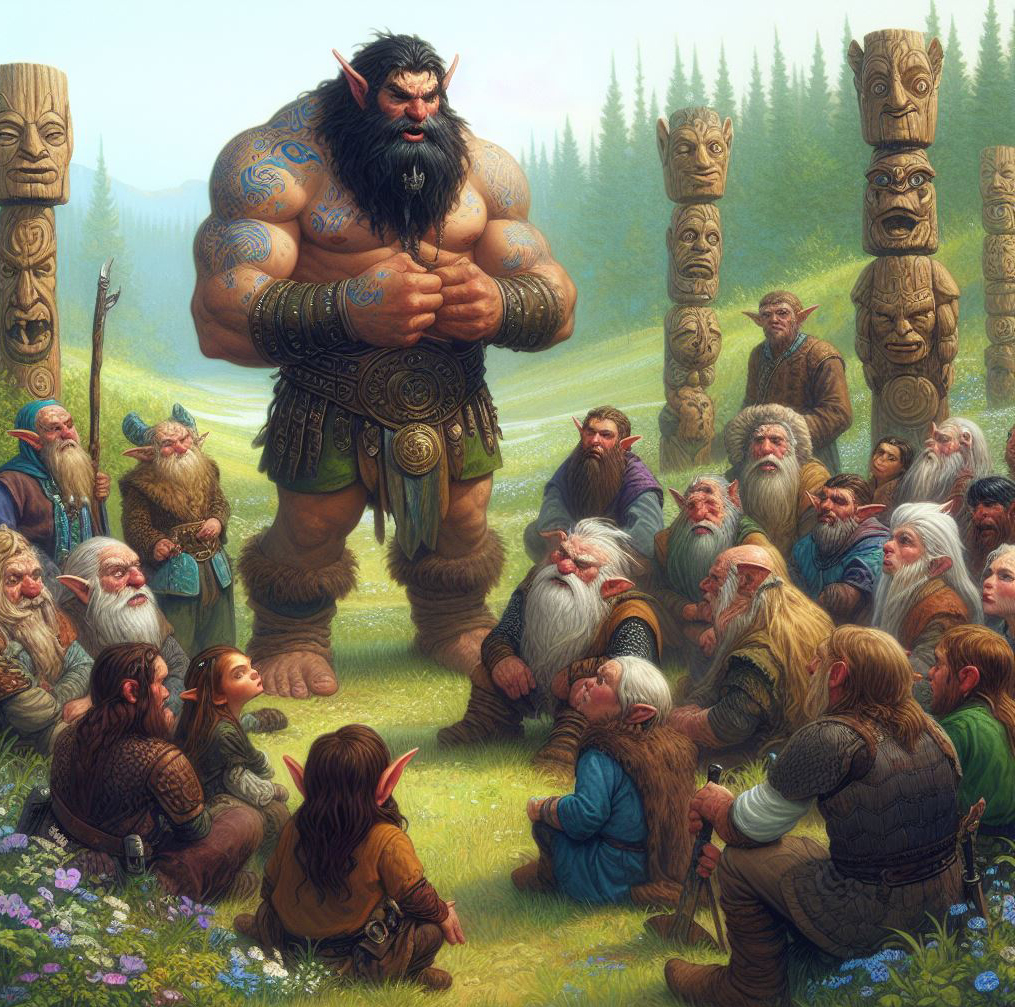
As some of the Drakk- and Ljost-alfar became vampires, several previous hidden races, like Jotunn, Risar, Etin, and Faerie, made their appearance and participated in the conflict that built. Some say it was in this conflict that the 'missing link' occurred, causing Erectus to evolve into the Archaic species.
Anyway, after the vampires birth, Dwarves Sealkin, Aquerian, T'Aurs, Kobold, Sproblin, and Ye'Til came around. Some aided the vampiric alfars, some opposed them. One thing can be drawn from this event, although it is unclear and pure speculation, as the divines seemingly had no knowledge of these n-erectus. Some had known the altered Drakk and Ljost Alfar for a while.
Skjald Sejrik
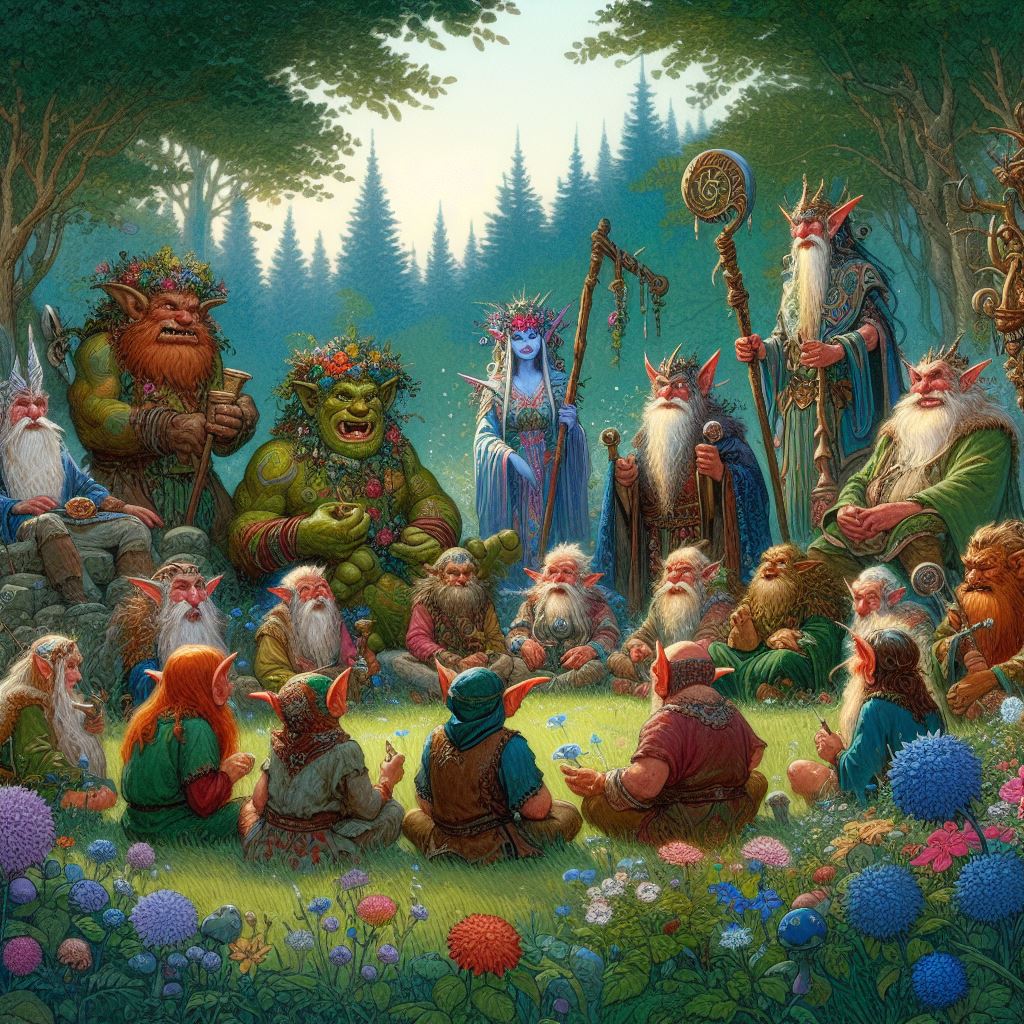
Then, after that great conflict, among a myriad of archaic species bubbling forth, Mammutan, Fautyr, Kinoblin, Anurai, and Pigryn came into the picture of those that interacted. But luckily, many of these interactions were so sparse and in times so distant that most cant recall them, as back then those void gardens razed went unnoticed unless the victors bragged about it.
Time passed and these n-erectu all found their place amongst one another, and then the divines decided to prevent further astral tainting of void things, and they took all void gardens and stitched them together. Creating a huge blanket of gardens, which they wrapped around the astral—and how they did that—bewilders me, as I thought the astral was boundless. But I guess the divines are just that for a reason. And our world was created.
Skjald Sigurd
First Age
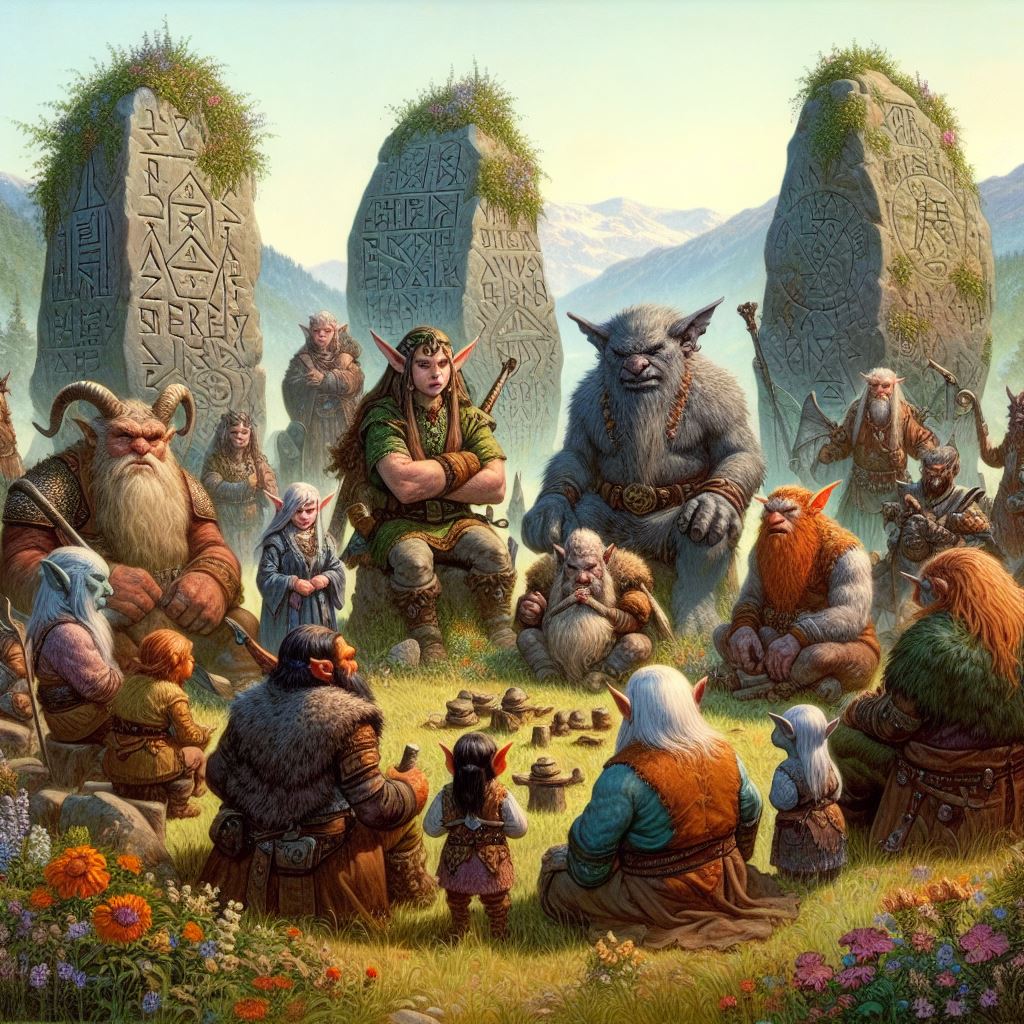
Total chaos occurred as the world was created; not only were void gardens thrown around, paths long trodden suddenly ripped apart, and travel sites defunct, but there was no light, no shine, no glow—nothing at all to show where feet were placed. So everything became hazardous, and only the few races that could see in the dark had any problems. It is also said that the stirring of the void and this darkness brought several foul monsters to the camps of many races. So, hundreds of living souls were lost as these foul things rampaged. Some, luckily enough to know fire, also had a slight defence against this darkness and the monsters.
Then suddenly, a faint glow became ever brighter and rose up and sailed in the sky, between our world and the void. Many a race cheered this new beacon, and it became as praised as divines, for some even more. In fact, it was a divine Male thursar that had been persuaded by all other divines to become imbued with energies from all other divines and enhanced to draw energy from the astral. Who would have been able to withstand such an offer, especially if one was a thursar of fire, beats me, especially if, on top of outshining all others, one would be able to draw on energies from all others—as we’ve been told, the connection also brings shared wisdom. So, this’son of all’ or Sun, as we call it, sees and knows all but the nightly things.
Those nightly things of shadows and chill are though covered by and known to another thrusar, a Female of the water element that became the mirror of the sun, the silvery shine, the embracer of all things, ‘the mother’, or Moon as we call her. Typically for a female water thurse, she was not rushing into the first light position, but when the full position of the light mirroring dawned upon her, she hesitated no longer and, some say, gladly accepted a position several other thursars and even gods would gladly have taken.
Anyway, both shines came as welcomed guidance for many races, and the monsters of the world wriggled their way back to the void or into the astral. Leaving our world a place for those willing to interact, learn, and teach. So all races began to improve. Skills, creating ever more stunning Items and Objects. Philosophy, Science, Crafting, and much more, enlightened their daily doings. But with all this also came an urge for the knowledge others possessed and the things they had. So, conflicts began to grow.
Skjald Vinotis
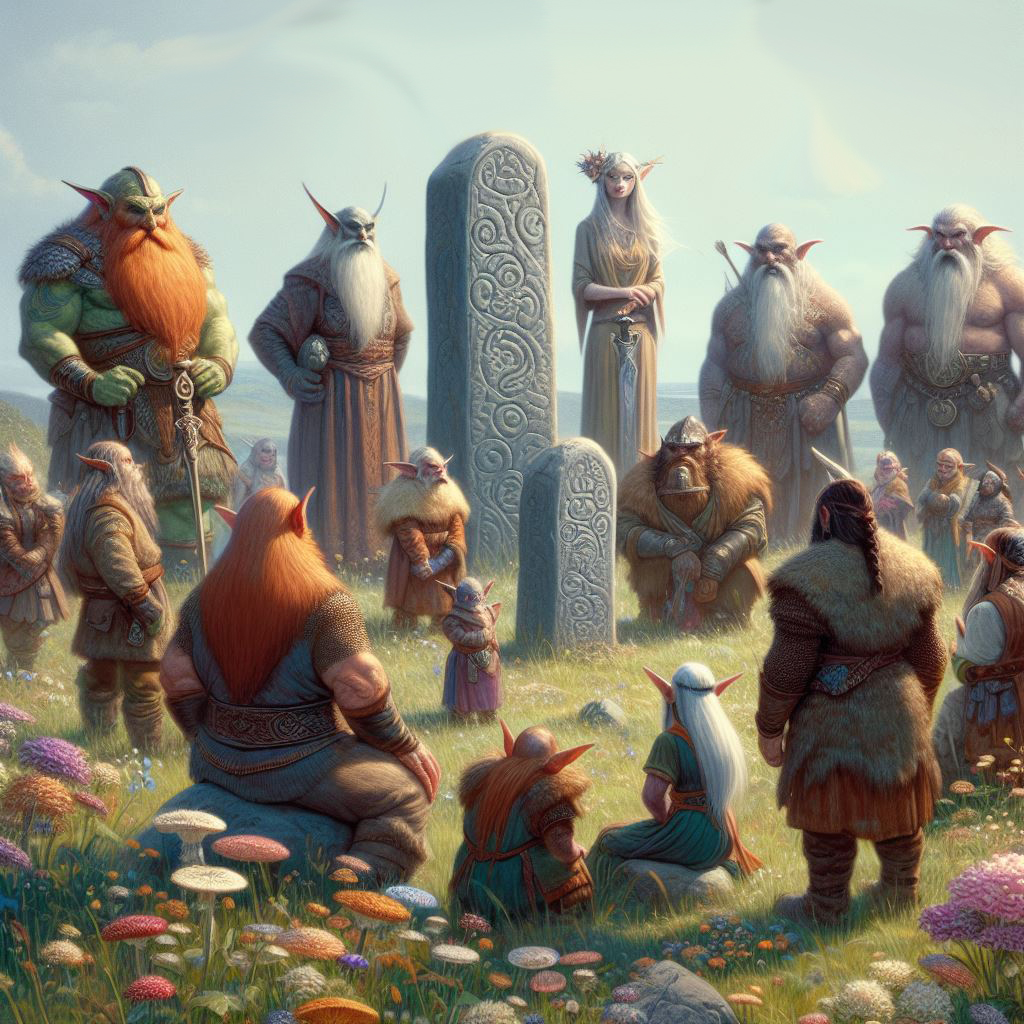
As the first age unfolded, races evolved, and especially humans multiplied in vast numbers as well. Some Tribes of various races prospered to such an extent that they became dominant and began to suppress others. Most of the N-Erectu disliked this rash urge for insight and possession, so they retracted from most interactions and became secluded tribes. Only Fautyr was as aggressive as those inflicting damage upon the prosperous coexistence, and they struck their foes with swift, merciless raids.
Thus, Fautyr became known as nature’s guardians, mostly as an excuse for their wild hunts. Their harsh retaliations towards humans and the yabbering gods, which always came trailing in the slipstream of the clawing flood, were with the blessing of Wickeryadi. As human mana manipulators, always needing ingredients for their Magic Paths, as well as Boriac interference, would quickly ruin whatever was found. And the Wickeryadi preferred that their hidden herb gardens stay untainted.
Skjald Valgrif
Second Age

Then came the most disturbing of humans from below The Rim and Wanderers. consisting of Rimzir, Vular, and Jomzaar flooded the shores of many a N-Erectu and Indigenous tribe. At first exchanging gifts and trading, then settling, marrying, and, as with other humans, urging for dominance. Leading to quite a lot of conflicts, but also some spectacular events and innovations. Most likely, there are several races we don’t know of living below the Rim or in the Outlands. But since there are no records, there are no tales but speculations to tell, so it is better to keep to the plenitude of known ones.
Fautyr, now with even more humans to wildly hunt, became one of the most openly known of the N-Erectu. Yet, as they often allied with T’Aurs and Kobold, these three became increasingly known among humans. Even more than both the Alfars’ and the Dwarves. Although, despite the N-Erectu presence in each and every country across our world, there were humans who considered them pure imagination.
As the Vular War brewed up, most did, though they became aware of the often wiser, older, stronger, and more skilled races. But if the N-Erectu was fed up with humans, constantly clawing for space, knowledge, and Resources, they were in for a surprise, as yet another ‘human lot’ would appear. The Ljostari sinking and Mt. Ljostia eruption into Mt. Vula created a great wave called the Deep Blue Tsunami, which flushed out the Arisen, previously dead humans, blown into existence by a tainted soup of mixed astral, void, and worldly mud.
Skjald Ulrich
Fourth Age

A world in chock… from the Deep Blue Tsunami and the Arisen… N-Erectu mourned losses…
Ljost Alfar’s cradle is gone… T’Aurs tree, but ashes now… Dwarves too, as Mt. Vula killed their house…
Wild energies flushing tunnels and halls of their realm… the 1st house dead or transformed…
Now odd trinity imps… of molten Dwarves lava, swirling alfar mana, and a tree’s life.
Skjald Kazumix
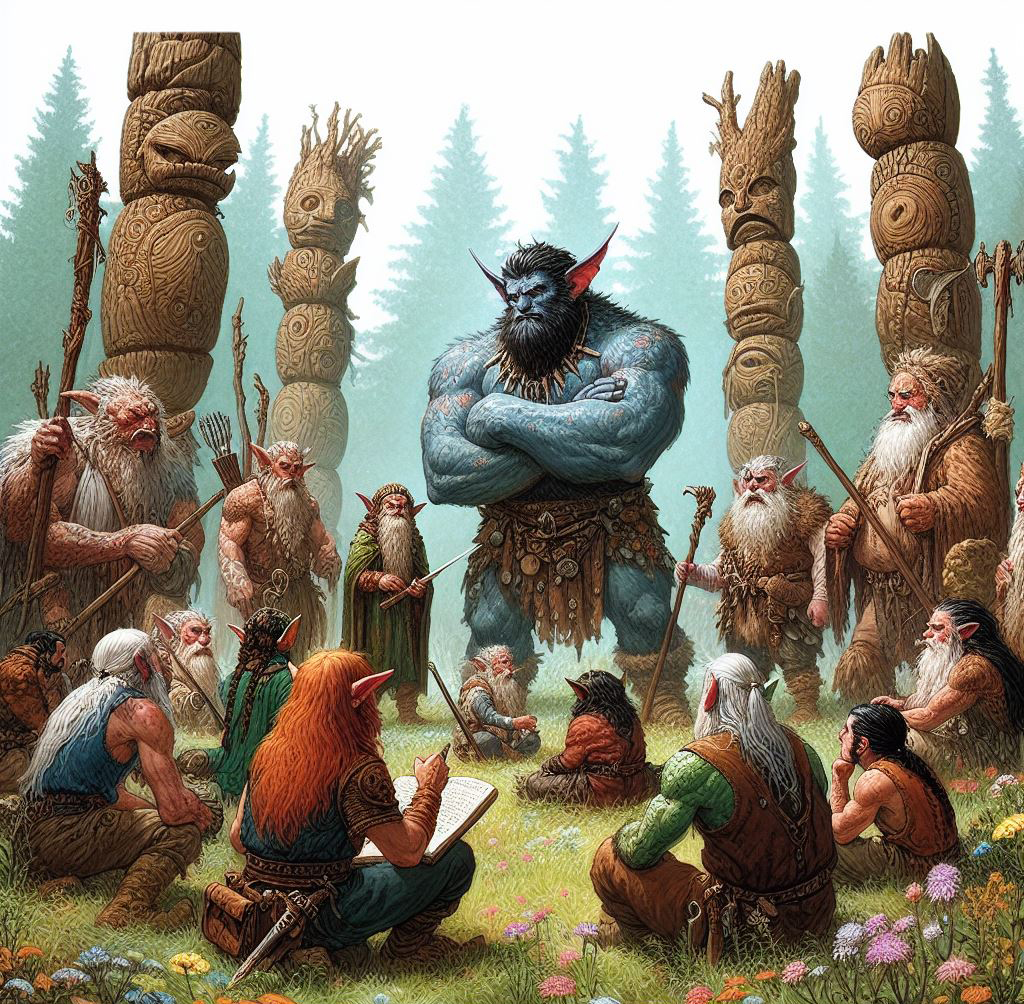
Oddly enough, the only N-Erectus altered by the disaster were those directly touched by the eruption; the Deep Blue Tsunami-tainted waters only affected humans. Not even the divines have been able to explain this, as not even the gods, despite their origination from astral mana, have been able to fully explain the tainting. The closest we’ve got is that it might be the paste from the Eternal Bush the T’Aurs had there, which delivered the tainting component.
Regardless, the N-Erectus was far quicker to recover from the disaster than humans, as they generally lived on higher ground. In the aftermath, they aided humans far more than most humans would have, but it renewed the interaction among races. Firing off a quicker recovery for all and an improved exchange of inventions and lore. Some great N-Erectus communities grew up from this.
But clouds also began to darken, as some humans began to embrace the foul artificial existence of Liches. Clawing space for their realms where they saw fit, mostly away from the plenitude of humans, they used their Magic and gathered minions to occupy Earthnodes as those places enhanced their powers. Often, these places were thought to be already homes for N-Erectus, leading to some nasty fights and sad losses.
And then some human families began to topple their former lords; a chaotic time of increased human warfare known as the Age of Hordes dawned. A horrible time lasting up until 1250, when finally a human High King managed to create The Realm bringing peace to all areas of all Isles. Sadly, this lasted but a brief moment in the wheel of time, as The Great Invasion took place in 1277.
As the invasion unfolded, it became clear to everyone that it was not just humans being hunted, killed, and enslaved. Even Arisen and those of N-Erectus were prey for the murderous invaders and their lackeys. Thus, the N-Erectus began to join the 2nd Alliance and fight against invaders. After their unified victory at Battle of Weeping Plains, most did though disband again, so it was but a few of their numbers that joined the Cleansing Crusade.
Skjald El Mary
Cartography
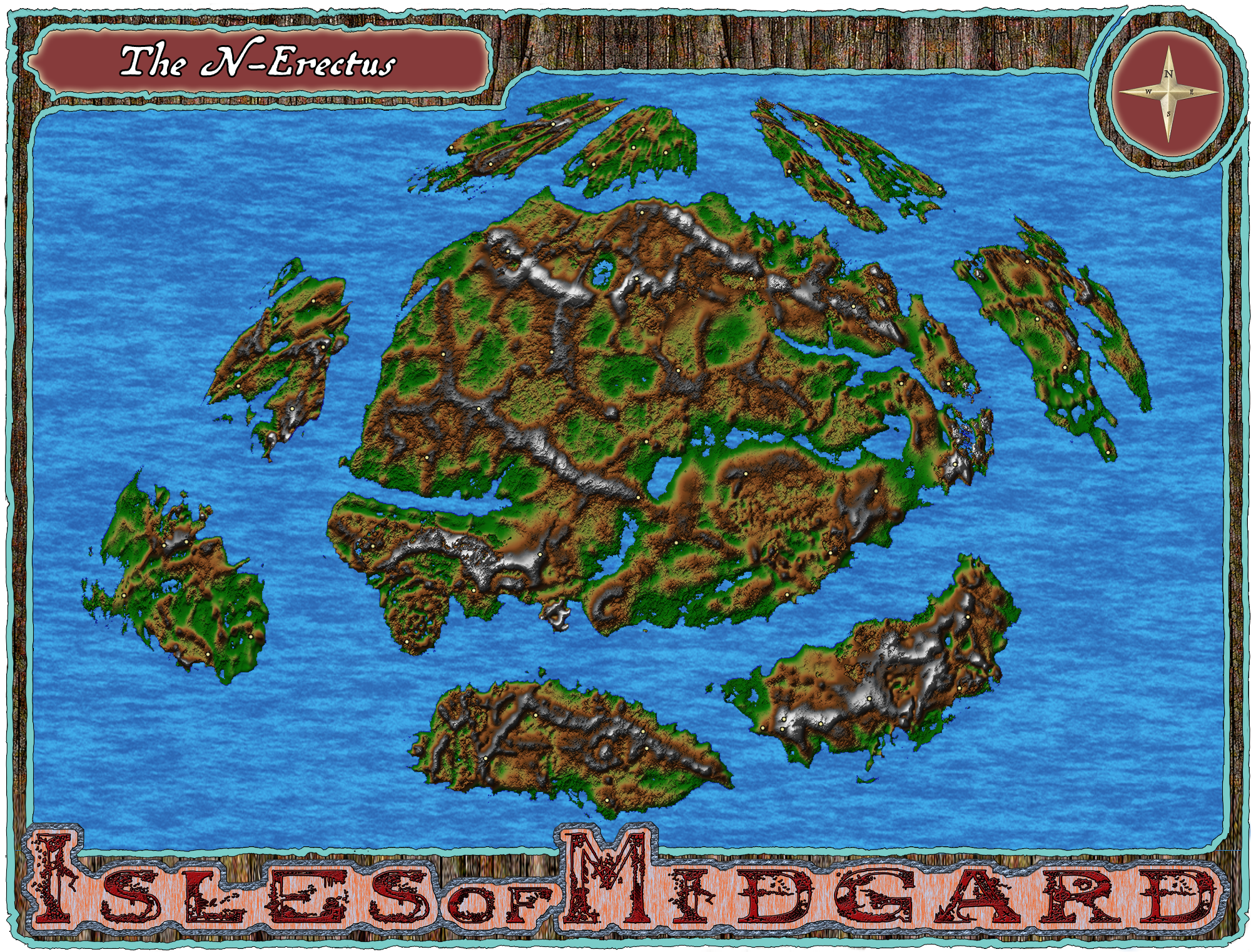
Here you can see the known locations of major N’Erectus settlements. Thus far, I have highlighted the locations of Dwarves, Drakk Alfar, and Ljost Alfar.
Skjald Sigurd
Organisation

N-Erectu and humans coexist through a system of segregation, mutual respect, and somewhat limited integration, with occasional interactions and cooperation between the two groups.
Social Interactions:
While N-Erectu and human races typically live in distinct societies, there are examples of integration and intermingling, especially at borderland locations like trading houses where they meet to barter commodities and resources.
Some people of both species prefer to live together, building mixed villages in which marriages and friendships between N-Erectu and humans are widespread.
Cultural interactions occur on a rare basis, with individuals of both races participating in N-Erectu and human customs, including festivals, celebrations, and ceremonies.
Political Interactions:
Representatives from the N-Erectu and human races join councils or assemblies to address issues of mutual concern, such as trade deals, territory conflicts, and shared resources.
Treaties and agreements between N-Erectu tribes and human kingdoms provide principles for interaction and collaboration, guaranteeing peaceful cohabitation while preserving each group’s individuality.
Disputes between races are resolved via diplomatic discussions and mediation, with the goal of finding mutually acceptable solutions that protect the rights and interests of all interested parties.
Technological Interactions:
Trade between N-Erectu and human races thrives in borderlands and trade houses, where raw materials, resources, and items valued by both groups are exchanged.
N-Erectu and humans exchange knowledge and experience in a variety of domains, including agriculture, handicraft, and magic, via collaborative and mutual learning.
The interchange of ideas and technology promotes innovation and invention, resulting in developments that benefit both races and add to the realm’s general prosperity.
Involvement of the Gods:
While the gods normally keep a distant presence in the mortal sphere, they do occasionally opt to meddle directly in the affairs of N-Erectu, as well as people and races.
Gods may manifest in physical form to converse with mortals, providing advice, wisdom, or warnings of future dangers or conflicts.
Temples and shrines devoted to the gods serve as meeting places for worship and spirituality, bringing people of all races together to seek heavenly blessings and guidance.
Skjald Sejrik
Last Updated on 2024-10-31 by IoM-Christian
